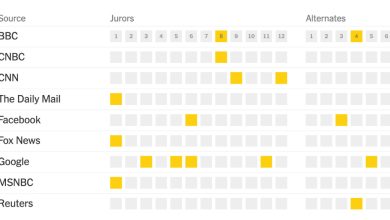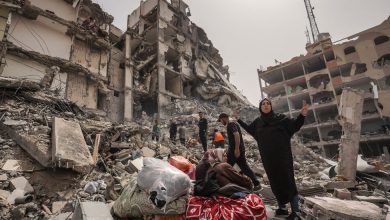House Hunting in Peru: A Modern Mountain Perch Above Lima

An Airy Eight-Bedroom Villa in Lima, Peru
$2 MILLION (7.4 MILLION PERUVIAN NUEVO SOL)
A stone mountain rises behind this geometric 12,055-square-foot house in La Planicie, an affluent neighborhood in the eastern La Molina district of Lima, Peru. Designed by Peruvian firm Domenack Arquitectos and built in 2014, the seven-bedroom, eight-bath house incorporates natural elements like an indoor waterfall and volcanic stone around the pool deck.
“All of La Molina is surrounded by large rock formations, and this house has its own mountain,” said Fernando Bertetti of Peru Sotheby’s International Realty, the listing broker. “But the home itself is modern and elegant, and the architects who designed it are very well-known.”

The 12,055-square-foot house, in the eastern La Molina district of Lima, was designed by the Peruvian firm Domenack Arquitectos with seven-bedrooms and eight bathrooms.Credit…Courtesy of Perú Sotheby’s International Realty
A 50-foot stone walkway leads from a gated street entrance to wooden front doors, which contrast with the concrete facade. The doors open to a foyer with black granite-slab floors. A square archway separates the foyer from a great room with 19.5-foot cathedral ceilings and cojoba wood floors. Full-length windows offer views of the backyard pool and hilly terrain beyond.
The kitchen, with glossy white cabinets and gray quartzite countertops offsetting a wooden breakfast bar, is concealed by a wall that houses a wide ethanol fireplace. The home’s main level also includes a small office, a bar and a two-bedroom guest suite.
On the second floor are five en suite bedrooms including the primary suite, which has a terrace. Two more bedrooms share a bathroom.
An indoor/outdoor waterfall flows from the home’s main level to the basement, which has a screening room, guest bathroom and kitchenette. The waterfall begins at the edge of the concrete pool deck, which is inlaid with Peruvian volcanic stone. A snaking steel sculpture forms a canopy over the rear terrace, and the 60-foot pool is surrounded by landscaping. “Lima is a desert, so anything planted is done by a gardener,” Mr. Bertetti said.
In the mountain behind the house, the owner carved niches called andenes, versions of farming “terraces” used by Inca people in pre-Colombian times. “Each of those little cutouts has a garden or a staircase,” Mr. Bertetti said.
Lima, Peru’s capital and largest city, is home to nearly 9.8 million residents in 43 urban districts covering about 1,000 square miles. Quiet and leafy, La Molina is favored by “wealthy families, expats and embassy workers,” Mr. Bertetti said. “There are only houses here, no tall buildings.” Private schools including the exclusive Colegio Franklin Delano Roosevelt/The American School of Lima are a draw, as is the upscale Country Club La Planicie, a half-mile west of the house. San Isidro, Lima’s central business district, is about 10 miles west, as is Jorge Chavez International Airport and Peru’s Pacific coastline.
Market Overview
Many wealthy Peruvians have been nervous since last year’s election of Marxist-Leninist president Pedro Castillo, who in February swore in his third cabinet in six months. As a result, Lima’s luxury market has “frozen,” said Ivan Zalaquett, a partner at Keller Williams Peru in Lima. “Clients with money think it’s too risky to invest here, and they’re looking in places like Miami.”
Prices at the high end have declined about 20 percent since the elections last year, said Nella Pinto, the head of Peru Sotheby’s International Realty in Lima.
“Unlike other countries, it’s been a buyer’s market,” she said. But Peru’s economy, driven by mining and commodities, “has remained strong, and people are realizing Peru isn’t changing. Prices will only go up.”
According to Ms. Pinto, prices in central Lima’s upscale neighborhoods, including San Isidro and Miraflores, range from $3,000 to $6,000 a square meter. In La Molina, where this home is located, prices average $1,500 a square meter.
Because of inflated property prices abroad, the exodus of wealth is starting to boomerang, said Juan Carlos Tassara, CEO of property developers Edifica and president of the Asociacion de Empresas Inmobiliarias del Peru (AESI), a real estate industry group. “Peruvians who left are realizing you can’t really get a good return on your investment in the U.S.,” he said.
The pandemic has also shifted Lima’s market dynamic. “There has been an increase in demand for properties outside the city” in surrounding districts and coastal communities, said Alen Becerra, founder and owner of Becerra Group/Leading Real Estate Companies of the World, in Lima.
But those transplants have not completely abandoned the city center, said Mr. Zalaquett of Keller Williams: “Whoever can buy a second home here doesn’t need to sell their primary residence.”
There is no central database for property transactions in Peru. Mr. Becerra estimated average prices in the city’s Lima Top sector, which includes La Molina, Miraflores, San Isidro, San Borja, Surco and Barranco, at about $2,288 a square meter ($215 a square foot). In the less affluent neighborhoods of the Modern Lima sector, including Jesús María, San Miguel, Lince, Magdalena del Mar, Pueblo Libre and Surquillo, where demand is higher, prices average $1,871 a square meter ($175 a square foot), he said. In new developments across the city, prices rose 7 percent year over year, a reflection of perennial demand for housing, Mr. Becerra said.
Demand remains strong at the middle and lower end of the market, said Jose Luis Alzamora, CEO of TALE Inmobiliaria, a Lima property developer. “The main offices of everything are in Lima,” he said. “That’s always put pressure on people who want to live here. That’s why we sell to working-class buyers, who need to buy somewhere to live, rather than the A market, who are now diversifying and largely stopping their investment in Peru.”
Mr. Zalaquett of Keller Williams said the “sweet spot” for Lima apartments outside the wealthiest neighborhoods ranges from $80,000 to $150,000.
A report from AESI, the real estate association, estimated that average prices across metropolitan Lima rose 14.7 percent from February 2021 to February 2022. According to data from the Central Reserve Bank of Peru shared by Mr. Becerra, prices per square meter are expected to increase 6 percent by the end of 2022. But Mr. Tassara, the developer, attributed rising prices to higher construction costs, “not because the market’s incredible.”
Who Buys in Lima
Middle-income Peruvians power Lima’s property market, Mr. Alzamora said. “People continue to get mortgages to buy their first home, or to move somewhere better than where they are,” he said. “Politics may worry them a bit, but they have more confidence than wealthy buyers.” The biggest challenge, he said, is finding buildable land to address a perennial housing shortage.
Most foreign buyers are retirees from North America, Spain and Britain, Mr. Becerra said. They look to coastal communities outside central Lima, drawn by relatively low prices and an enviable climate. Expatriate Peruvians are a “significant” part of the high-end market, he said.
Foreigners who move to Lima for corporate postings usually rent rather than buy, Mr. Zalaquett said. “I haven’t had any foreign buyers. And Peruvians who moved abroad are only looking to sell the homes they kept here,” he said.
Buying Basics
There are few restrictions on foreign buyers in Peru. “Non-Peruvians can’t own land within about 30 miles of our borders, but there are no cities there anyway,” said Jorge Picon, co-founder of Picon Asociados, a legal and tax consulting firm in Lima. The buying process is the same for foreigners and Peruvians, he said, though money-laundering laws have tightened, so “money has to come from a country that’s not considered a tax haven by Peruvian law,” like Panama. That could become a problem.”
Foreigners must open an account at a Peruvian bank to execute a property transaction, “but anyone can do that in five minutes here,” Mr. Picon said. Foreigners can obtain mortgages through Peruvian banks, though many choose to pay cash, he said.
Notaries oversee property transactions in Peru. “They control the process, from basic due diligence on the property to creating the deed to paying taxes due upon completion of the transaction,” Mr. Picon said.
Many property transactions take place in U.S. dollars, Mr. Picon said.
Websites
-
Peru Tourism: peru.travel
-
Peru government: gob.pe
-
La Molina government: munimolina.gob.pe
Languages and Currency
Spanish; nuevo sol (1 nuevo sol = $0.27)
Taxes and Fees
Foreign buyers and Peruvian citizens pay the same taxes on home purchases, said Oscar Picon, co-founder of Picon Asociados and Jorge Picon’s brother. “A 3 percent tax on the value of the property is the only tax anyone pays upon purchase,” he said, noting that an 18 percent value-added tax applies only to new construction purchased from the developer. Independent professionals like lawyers and accountants do not charge a value-added tax on their services, but legal or accounting firms must apply the VAT.
Until 2016, foreign property sellers in Peru had to pay a flat 30 percent tax on capital gains. To encourage foreign investment, the government reduced the tax rate for individual non-Peruvians to 5 percent on capital gains. Foreign corporations must still pay the 30 percent tax.
Notary fees are set by the government at approximately 1.5 percent of the property value. Real estate commissions in Peru average 3 to 5 percent, Ms. Pinto said.
Annual property taxes on this home total about $3,000, Mr. Bertetti said.
Contact
Fernando Bertetti, Peru Sotheby’s International Realty, 011-511-417-2400, perusir.com
For weekly email updates on residential real estate news, sign up here. Follow us on Twitter: @nytrealestate.




